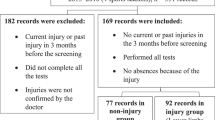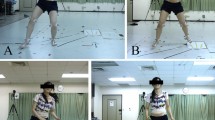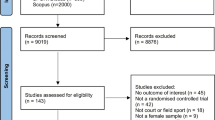Abstract
Background
Female soccer players have a higher anterior cruciate ligament (ACL) injury rate than male players, possibly due to sex-specific intrinsic risk factors. The Landing Error Scoring System (LESS) and the Step-Down Test (SDT) have been used for screening the ACL injury risk, but the performance of adult soccer players in these field-based tests remains unclear.
Purpose
To compare the performance of well-conditioned male and female soccer players on two field-based tests for screening the ACL injury risk: the LESS and the SDT.
Methods
Sixty-seven soccer players from first state division teams were part of this study: 36 men (20 ± 1 years) and 31 women (21 ± 2 years). All players had no ACL injury history, and performed both tests in their clubs’ facilities.
Results
No significant difference between groups was found for total score on the LESS [male = 2.56 ± 1.25 (2.14; 2.98); female = 2.81 ± 1.64 (2.21; 3.41); p = 0.779] or the SDT [male = 2.61 ± 1.02 (2.26; 2.96); female = 2.97 ± 0.95 (2.62; 3.32); p = 0.280]. A greater percentage of females counted “errors” related to knee medialization and trunk-flexion displacement during LESS execution, while males failed more often in relation to foot positioning. Distribution of “errors” on the SDT was similar between sexes.
Conclusions
Male and female professional soccer players presented similar total scores in the LESS and the SDT. However, female players seem to present some landing features potentially harmful to the ACL (related to dynamic knee valgus and poor trunk-flexion displacement) more often than males.
Level of evidence
3a.


Similar content being viewed by others
References
López-Valenciano A, Ruiz-Pérez I, Garcia-Gómez A, Vera-Garcia FJ, Croix MDS, Myer GD, Ayala F (2020) Epidemiology of injuries in professional football: a systematic review and meta-analysis. Br J Sports Med 54(12):711–718
Faude O, Junge A, Kindermann W, Dvorak J (2005) Injuries in female soccer players: a prospective study in the German national league. Am J Sports Med 33(11):1694–1700
Jacobson I, Tegner Y (2007) Injuries among Swedish female elite football players: a prospective population study. Scand J Med Sci Sports 17(1):84–91
Tegnander A, Olsen OE, Moholdt TT, Engebretsen L, Bahr R (2007) Injuries in Norwegian female elite soccer: a prospective one-season cohort study. Knee Surg Sports Traumatol Arthrosc 16(2):194–198
Ekstrand J, Krutsch W, Spreco A, van Zoest W, Roberts C, Meyer T, Bengtsson H (2020) Time before return to play for the most common injuries in professional football: a 16-year follow-up of the UEFA elite club injury study. Br J Sports Med 54(7):421–426
Eliakim E, Morgulev E, Lidor R, Meckel Y (2020) Estimation of injury costs: financial damage of English premier league teams’ underachievement due to injuries. BMJ Open Sport Exerc Med 6(1):e000675. https://doi.org/10.1136/bmjsem-2019-000675
Niederer D, Engeroff T, Wilke J, Vogt L, Banzer W (2018) Return to play, performance, and career duration after anterior cruciate ligament rupture: a case-control study in the five biggest football nations in Europe. Scand J Med Sci Sports 28(10):2226–2233
Bahr R, Krosshaug T (2005) Understanding injury mechanisms: a key component of preventing injuries in sport. Br J Sports Med 39(6):324–329
Della Villa F, Buckthorpe M, Grassi A, Nabiuzzi A, Tosarelli F, Zaffagnini S, Della VS (2020) Systematic video analysis of ACL injuries in professional male football (soccer): injury mechanisms, situational patterns and biomechanics study on 134 consecutive cases. Br J Sports Med 54(23):1423–1432. https://doi.org/10.1136/bjsports-2019-101247 (Epub 2020 Jun 19 PMID: 32561515)
Bell DR, Kulow SM, Stiffler MR, Smith MD (2014) Squatting mechanics in people with and without anterior cruciate ligament reconstruction: the influence of graft type. Am J Sports Med 42(12):2979–2987
Briem K, Jónsdóttir KV, Árnason A, Sveinsson Þ (2017) Effects of sex and fatigue on biomechanical measures during the drop-jump task in children. Orthop J Sports Med 5(1):2325967116679640
Petrovic M, Sigurðsson HB, Sigurðsson HJ, Sveinsson T, Briem K (2020) Effect of sex on anterior cruciate ligament injury-related biomechanics during the cutting maneuver in preadolescent athletes. Orthop J Sports Med 8(7):2325967120936980
Sigurðsson HB, Sveinsson Þ, Briem K (2018) Timing, not magnitude, of force may explain sex-dependent risk of ACL injury. Knee Surg Sports Traumatol Arthrosc 26(8):2424–2429. https://doi.org/10.1007/s00167-018-4859-9 (Epub 2018 Feb 10. PMID: 29429044; PMCID: PMC6061759)
Sigward SM, Powers CM (2006) The influence of gender on knee kinematics, kinetics and muscle activation patterns during side-step cutting. Clin Biomech (Bristol, Avon) 21(1):41–48
Jenkins WL, Williams DS 3rd, Williams K, Hefner J, Welch H (2017) Sex differences in total frontal plane knee movement and velocity during a functional single-leg landing. Phys Ther Sport 24:1–6. https://doi.org/10.1016/j.ptsp.2016.09.005 (Epub 2016 Sep 6 PMID: 28013024)
Ishida T, Koshino Y, Yamanaka M, Ueno R, Taniguchi S, Samukawa M, Saito H, Matsumoto H, Aoki Y, Tohyama H (2018) The effects of a subsequent jump on the knee abduction angle during the early landing phase. BMC Musculoskelet Disord 19(1):379. https://doi.org/10.1186/s12891-018-2291-4 (PMID:30342498; PMCID:PMC6195693)
Chia L, Andersen JT, McKay MJ, Sullivan J, Megalaa T, Pappas E (2021) Evaluating the validity and reliability of inertial measurement units for determining knee and trunk kinematics during athletic landing and cutting movements. J Electromyogr Kinesiol. https://doi.org/10.1016/j.jelekin.2021.102589
Padua DA, DiStefano LJ, Beutler AI, de la Motte SJ, DiStefano MJ, Marshall SW (2015) The landing error scoring system as a screening tool for an anterior cruciate ligament injury-prevention program in elite-youth soccer athletes. J Athl Train 50(6):589–595
Padua DA, Marshall SW, Boling MC, Thigpen CA, Garrett WE, Beutler AI (2009) The landing error scoring system (LESS) is a valid and reliable clinical assessment tool of jump-landing biomechanics. Am J Sports Med 37(10):1996–2002
Rabin A, Kozol Z (2010) Measures of range of motion and strength among healthy women with differing quality of lower extremity movement during the lateral step-down test. J Orthop Sports Phys Ther 40(12):792–800
Park KM, Cynn HS, Choung SD (2013) Musculoskeletal predictors of movement quality for the forward step-down test in asymptomatic women. J Orthop Sports Phys Ther 43(7):504–510
Anderson T, Wasserman EB, Shultz SJ (2019) Anterior cruciate ligament injury risk by season period and competition segment: an analysis of national collegiate athletic association injury surveillance data. J Athl Train 54(7):787–795
Gupta AS, Pierpoint LA, Comstock RD, Saper MG (2020) Sex-based differences in anterior cruciate ligament injuries among United States high school soccer players: an epidemiological study. Orthop J Sports Med 8(5):2325967120919178
Huang YL, Jung J, Mulligan CMS, Oh J, Norcross MF (2020) A majority of anterior cruciate ligament injuries can be prevented by injury prevention programs: a systematic review of randomized controlled trials and cluster-randomized controlled trials with meta-analysis. Am J Sports Med 48(6):1505–1515
Bigoni M, Turati M, Gandolla M et al (2017) Balance in young male soccer players: dominant versus non-dominant leg. Sport Sci Health 13:253–258. https://doi.org/10.1007/s11332-016-0319-4
Hewett TE, Myer GD, Ford KR, Heidt RS Jr, Colosimo AJ, McLean SG, van den Bogert AJ, Paterno MV, Succop P (2005) Biomechanical measures of neuromuscular control and valgus loading of the knee predict anterior cruciate ligament injury risk in female athletes: a prospective study. Am J Sports Med 33(4):492–501
Earl JE, Monteiro SK, Snyder KR (2007) Differences in lower extremity kinematics between a bilateral drop-vertical jump and a single-leg step-down. J Orthop Sports Phys Ther 37(5):245–252
Munro A, Herrington L, Comfort P (2017) The relationship between 2-dimensional knee-valgus angles during single-leg squat, single-leg-land, and drop-jump screening tests. J Sport Rehabil 26(1):72–77
Hanzlíková I, Athens J, Hébert-Losier K (2021) Factors influencing the landing error scoring system: systematic review with meta-analysis. J Sci Med Sport 24(3):269–280. https://doi.org/10.1016/j.jsams.2020.08.013 (Epub 2020 Sep 12 PMID: 32951976)
Lopes TJA, Milena Simic M, Myer GD, Ford KR, Hewett TE, Pappas E (2018) The effects of injury prevention programs on the biomechanics of landing tasks: a systematic review with meta-analysis. Am J Sports Med 46(6):1492–1499
Smith HC, Johnson RJ, Shultz SJ et al (2012) A prospective evaluation of the landing error scoring system (LESS) as a screening tool for anterior cruciate ligament injury risk. Am J Sports Med 40(3):521–526
Author information
Authors and Affiliations
Corresponding author
Ethics declarations
Ethical approval
This study was previously approved under #804366.0.0000.5345 by the research ethics committee of the The Federal University of Health Sciences of Porto Alegre (UFCSPA), Brazil.
Informed consent
All participants signed an informed consent form before the start of data collection.
Additional information
Publisher's Note
Springer Nature remains neutral with regard to jurisdictional claims in published maps and institutional affiliations.
Rights and permissions
Springer Nature or its licensor holds exclusive rights to this article under a publishing agreement with the author(s) or other rightsholder(s); author self-archiving of the accepted manuscript version of this article is solely governed by the terms of such publishing agreement and applicable law.
About this article
Cite this article
Marques, V.B., Oliveira, D.F., de Borba Capaverde, V. et al. Performance of male and female soccer players in field-based tests for screening the anterior cruciate ligament injury risk. Sport Sci Health 19, 131–137 (2023). https://doi.org/10.1007/s11332-022-01011-1
Received:
Accepted:
Published:
Issue Date:
DOI: https://doi.org/10.1007/s11332-022-01011-1




